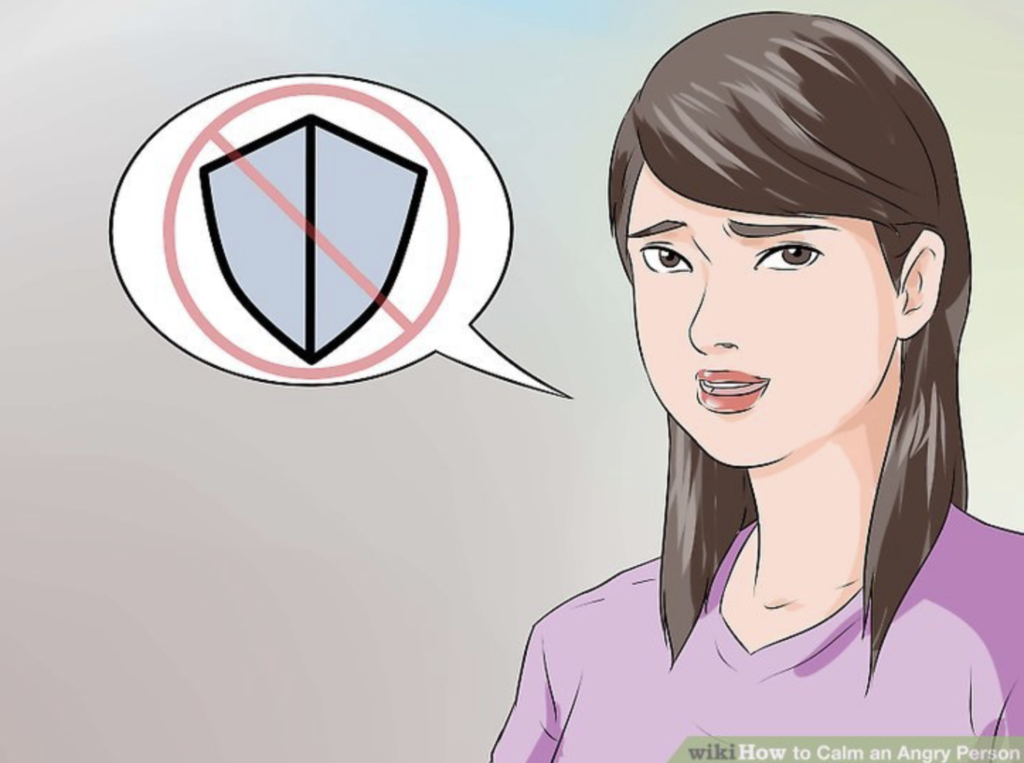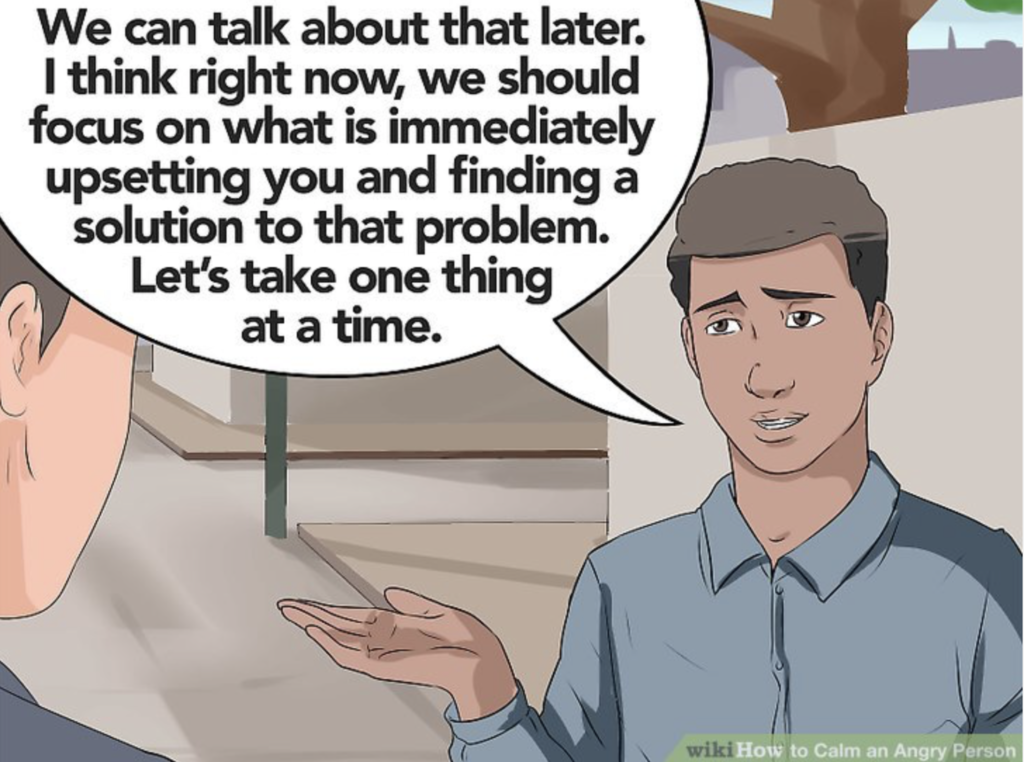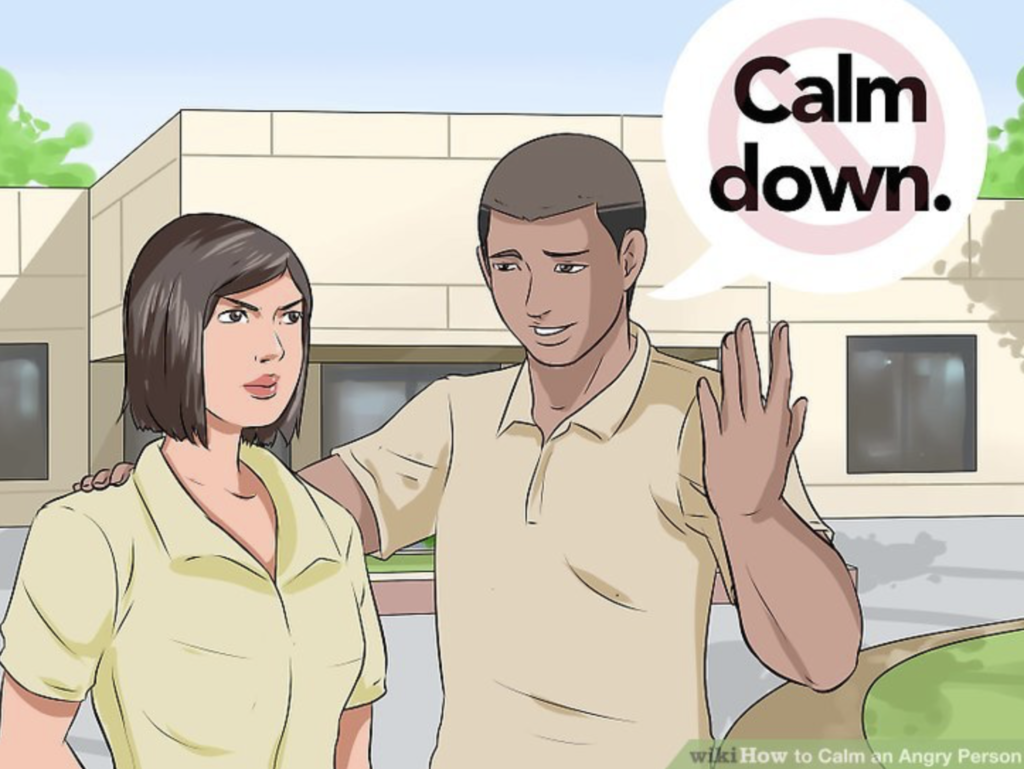by Chloe Carmichael, PhD: Calming an angry person requires a lot of patience…
When someone’s feeling heated up, hearing the words “calm down” may just make matters worse. Being a good listener and offering some good distractions can both help. However, when someone’s anger is explosive or unpredictable, walk away instead of attempting to use reason. If the angry person does not accept your apology, it is often best to give them some space and walk away.
Remaining Calm
Part 1.
Avoid a fight. When someone else is at a boiling point, getting equally angry is only going to make matters worse. Focus on keeping yourself calm, or else the situation might quickly spiral into an argument. This is not to say you should act completely unemotional, but try not to let your own feelings get too heated.
- A way to remain neutral is to let go of your own ego and not take things personally. It can be natural to respond to an angry person by defending yourself or your reputation, but it’s important to remember that someone who is very angry cannot be reasoned with until they have calmed down.
-
 2Try not to get defensive. When someone’s so mad they can barely speak in a level tone, it’s easy to absorb that negativity and feel defensive. When you’re communicating with someone who is angry, realize that the anger is likely not about you. Separate the person’s emotions from your own so you can be there for the person without feeling the anger is directed toward you.
2Try not to get defensive. When someone’s so mad they can barely speak in a level tone, it’s easy to absorb that negativity and feel defensive. When you’re communicating with someone who is angry, realize that the anger is likely not about you. Separate the person’s emotions from your own so you can be there for the person without feeling the anger is directed toward you. -
 3
3Stay in the present. People who are angry will often bring up situations or conversations from the past, particularly if they are trying to draw you into their anger. Try to counteract that by keeping them focused on the present situation and solving a solution to the current problem. Don’t let yourself get drawn in to feeling angry about past events.
- If the conversation seems to be drifting towards past events, try saying something like, “We can talk about that later. I think right now, we should focus on what is immediately upsetting you and finding a solution to that problem. Let’s take one thing at a time.”
-
 4
4Stay calm and quiet. If someone is yelling or venting, you can decide to let them vent to blow off steam, but the best thing for you to do is to remain quiet or to say nothing. If you do speak, keep a quiet level voice. If you remain quiet, try to keep a neutral facial expression and open body language. You remain in more control if you do not react to the “bait” of the person yelling.
- There is a difference between letting someone vent and being the victim of verbal abuse. If the person is berating you, calling you names, or directing unrelated anger towards you, you may want to make a statement such as, “I understand that you are frustrated and I would like to be here for you. But please do not take your anger out on me.”
- If someone is disrespecting you, address how you feel right away. If you push down your feelings, they’ll eventually bubble up in an angry outburst.
De-escalating Someone’s Anger
-
 1
1Apologize if you were in the wrong. If you did something to anger the person, maybe what they need is a heartfelt apology. Apologizing is not a sign of weakness. It shows that you care about the feelings of the other person. Reflect on the situation to see if you did something wrong, and if you did, say you’re sorry. Sometimes that’s all a person needs to hear to feel better about what happened.
- If you don’t feel you were in the wrong, however, then don’t apologize just to calm the person down.
- An effective apology may be, “I’m very sorry that I spent the money you were saving for retirement on a time share in Hawaii. I don’t know what I was thinking, and I can understand why you are angry. Let’s work together to find a solution.”
-
 2Don’t say “calm down.” Someone who is really angry is being ruled by their emotions and is not accessing the rational part of their brain. Trying to use reason or making suggestions to “remain calm” or “be reasonable” are likely to fuel the fire and make the person feel invalidated.
2Don’t say “calm down.” Someone who is really angry is being ruled by their emotions and is not accessing the rational part of their brain. Trying to use reason or making suggestions to “remain calm” or “be reasonable” are likely to fuel the fire and make the person feel invalidated. -
 3
3Use good listening techniques. When people are feeling emotional they want to know someone else understands. Really listen to the person talk. Look him or her in the eye, nod when appropriate, and ask questions to find out more. The act of conversing and feeling heard could help the person calm down.
- Of course, sometimes angry people don’t want to be asked questions, and they might feel so angry they don’t believe anyone can really understand. All you can do is try your best; if the person isn’t in the mood for a heart-to-heart, don’t force it.
-
 4
4Validate the person’s feelings. Everyone gets angry from time to time. Sometimes anger actually masks another emotion, like feeling hurt, embarrassed, or sad. Whatever the reason for the person’s anger, listen to them and respond by validating his feelings (without necessarily agreeing with them). You should also withhold judgment of the person, as judging will likely come through in your words or body language as a lack of support.
- An example of validating someone’s emotions is making statements like “that must be difficult” or “I understand how you could be frustrated.”
- Statements that are not as helpful include “you should let it go” or “I experienced the same thing and got over it.”
-
 5
5Show empathy. Empathy can take the form of understanding another’s perspective, feeling distress at the plight of another person, and being able to relate to the emotions of another. Showing empathy towards someone who is angry may take the form of showing that you have been listening to him and know what he is saying.
- To empathize with someone who is angry, try paraphrasing the source of their anger back to them. You might say, “So, you are saying that you feel angry because you think you have to take on all of the household responsibilities alone.”
- You may be inclined to say, “I understand how you feel,” but know that this can sometimes make someone more angry. They may believe that no one really knows how they feel.
-
 6Lighten the situation with humor. You may have to read the situation or know the angry person fairly well to determine whether this approach will work. Humor can effectively fight anger because it changes the chemical processes in the body. Making a joke or stopping and pointing out something funny in the situation and getting both of you laughing can diffuse the situation and could potentially snap the person out of his anger.
6Lighten the situation with humor. You may have to read the situation or know the angry person fairly well to determine whether this approach will work. Humor can effectively fight anger because it changes the chemical processes in the body. Making a joke or stopping and pointing out something funny in the situation and getting both of you laughing can diffuse the situation and could potentially snap the person out of his anger. -
 7
7Give the person some space. Some people are talkers, and some people prefer to process their emotions alone. If the idea of talking it out just seems to make the person madder, give them some space and time instead. Most people take at least 20 minutes to calm down from anger, but some may need even longer.
- If you think someone needs some time alone, try saying, “I understand that you are angry, but I don’t feel like I am helping you feel any better, and I think you may need a few minutes to yourself. I’ll be right here for you if or when you feel ready to talk.”
Working Towards a Solution
-
 1
1See if you can help the person make things better. If the source of the anger is related to a solvable problem, maybe you can help. If the person is calm enough to listen to reason, offer solutions and help to lay out a plan that will correct the situation.
- In some cases, an angry person can’t be reasoned with in this way. Assess the situation and determine whether you should wait until the person has calmed down enough to listen to positive reasoning.
- Ask the person to describe why they feel angry since it can help them understand their feelings more.
-
 2Focus on the future. It is important to focus on the present when processing feelings of anger, but you should try to get the person to focus on the future when finding a solution. This can help the person think more reasonably and focus on the improved results from the solution instead of continuing to dwell in the anger of the past or present.
2Focus on the future. It is important to focus on the present when processing feelings of anger, but you should try to get the person to focus on the future when finding a solution. This can help the person think more reasonably and focus on the improved results from the solution instead of continuing to dwell in the anger of the past or present. -
 3Help the person accept that there may not be a solution. Not every problem or situation that makes someone angry has a solution. If this is the case, it’s important to emphasize that the person needs to work through his emotions and move on.
3Help the person accept that there may not be a solution. Not every problem or situation that makes someone angry has a solution. If this is the case, it’s important to emphasize that the person needs to work through his emotions and move on.
Knowing When to Leave
-
 1Disengage if you cannot stay calm. If the person is pushing your buttons or enticing you to feel angry, you should leave if possible. Becoming angry yourself will likely cause the situation to worsen, so leaving when you feel angry can prevent an escalation or fight.
1Disengage if you cannot stay calm. If the person is pushing your buttons or enticing you to feel angry, you should leave if possible. Becoming angry yourself will likely cause the situation to worsen, so leaving when you feel angry can prevent an escalation or fight. -
 2
2Recognize abuse. Anger and abuse are not the same things. Anger is a normal human emotion that needs to be dealt with. Abuse is an unhealthy and potentially dangerous way of interacting with another. The following are strategies that indicate abuse, not anger:
- Physical intimidation (whether or not it leads to actual violence)
- Making you feel guilty
- Calling names or belittling
- Sexual control or coercion
-
 3
3Get to safety if the situation turns violent. If you’re dealing with a person who has anger management problems and you fear for your safety, leave right away and get to a safe place. Domestic abuse is an ongoing cycle, and if abuse happens once it’s likely to happen again. It’s very important for you to keep yourself and your family physically and emotionally safe. In the US, the domestic abuse hotline is 1-800-799-7233 (SAFE).Here are the signs that the situation might be abusive:
- You feel afraid of making the person angry
- The person humiliates you, criticizes you or puts you down
- The person has a violent and unpredictable temper
- The person blames you for his or her abusive behavior
- The person threatens to hurt you
Source: Wiki How










































